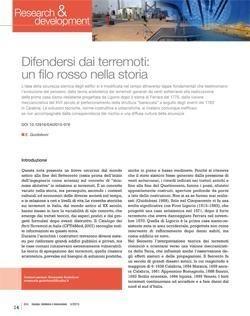L’idea della sicurezza sismica degli edifici si è modificata nel tempo attraverso tappe fondamentali che testimoniano l’evoluzione del pensiero: dalla teoria aristotelica dei terremoti generati da venti sotterranei alla realizzazione della prima casa sismo-resistente progettata da Ligorio dopo il sisma di Ferrara del 1770, dalla visione meccanicistica del XVII secolo al perfezionamento della struttura “baraccata” a seguito degli eventi del 1783 in Calabria. Le soluzioni tecniche, norme costruttive e urbanistiche, si rivelano comunque inefficaci se non accompagnate dalla consapevolezza del rischio e una diffusa cultura della sicurezza
Defence against earthquakes: a red thread of history
This note gives a short overview from the ancient world down to the end of the eighteenth century (before engineering began as a science, that is) on the idea of “housing safety” and earthquakes. The idea varies, but persists throughout the cultural and economic contexts of history’s changing societies, and in relation to class and lifestyle. Historical research into earthquakes in Italy from the ancient world to the twentieth century has shown how variable the idea actually is, as emerges from theoretical treatises, practical wisdom and projects drawn up in the wake of destructive events.
In the seventeenth century the theoretical interpretation of earthquakes began to swing towards a mechanistic view of the Earth, affecting how the effects and propagation of earthquakes were observed. Strong earthquakes continued to occur and cause damage, and after yet another seismic disaster – Umbria 1751 – new building techniques were advocated. The attempt was to make house walls bind more solidly by special linking of the wooden structure of floors and roof beams. Following the massive seismic crisis of February-March 1783, which left central and southern Calabria in ruins, a new house was proposed, called baraccata: it was a wooden structure filled in with light materials. This was actually already to be founding the ancient Mediterranean basin (including Pompei); but only at that time was it perfected, proposed by engineers and circulated as an important building innovation. At the end of the eighteenth century town planners came to the fore in the search for safe housing. They suggested new regular shapes, broad grid-plan streets with a specific view to achieving housing safety and ensuring an escape route in case of earthquake. Such rules and regulations were then abandoned or lost, proving that it is not enough to try out.


